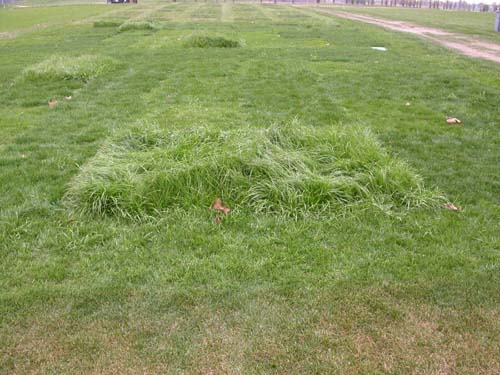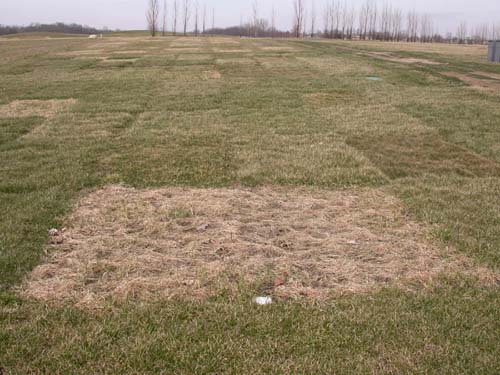There are many cool-season turfgrasses suitable and adapted to home-lawns in Indiana. They include; Kentucky bluegrass, turf-type tall fescue, fineleaf fescue and to a certain extent even “perennial” ryegrass. Many new lawns are established using seed because it is much less expensive than sod. Unfortunately, in many instances inexperienced homeowners or landscape contractors often purchase the least expensive seed, species or mixture because it is after all “just a lawn”. Many of the contractor’s mixes sold at big-box garden centers or co-ops contain annual ryegrass which can be as the name implies “annual”. Annual ryegrass by nature is a weak perennial, that is sometimes used for rapid, temporary soil stabilization or in row crops used as a winter cover crop to limit nutrient loss. It is not intended to be grown as a desirable perennial turfgrass species. If planted, it will form a semi-persistent, coarse textured, yellow-green turf that requires very frequent mowing (see photo 1). In many inexpensive lawn mixes or “patch” kits it is a dominant component of the seed mixture because it germinates quickly and makes you look like a hero, at least initially. Perhaps if you are lucky, environmental stress like cold or heat will rid your lawn of this grass species (see photo 2). The problem comes if annual rye has outcompeted more desirable turfgrass species during seedling establishment. When it goes, you are left with bare soil and have to start over.
We established an observation study here in West Lafayette, last September to evaluate various commercially available lawn species and mixtures. We independently purchased several lawn mixes from the local garden centers and also received high-quality professional grade turfgrasses as well. All were planted in early September, properly irrigated and fertilized to maximize establishment. Meaning they all had plenty of time to mature and get ready for winter (see photo 1). Annual ryegrass, as expected, established very rapidly and produced a significant amount of above-ground biomass, see the tall yellow-green, unattractive plots (photo 1). The grass was still present in January but last week upon my visit to the plots the turf in those same plots had more or less disappeared (photo 2). I guess we will start over.
My point… DO NOT plant annual ryegrass, purchase high quality seed from a professional turfgrass seed supplier and/or read the label of the seed bags, avoiding both ryegrasses if you can. If soil stabilization is your primary concern, turf-type tall fescue will germinate almost as quickly and leave you with a much more desirable, stress tolerant lawn than ryegrass. (Note: avoid Kentucky-31 tall fescue for lawns). Remember, buyer beware.

